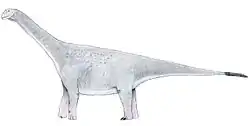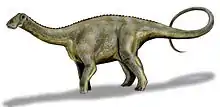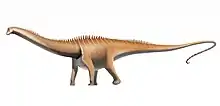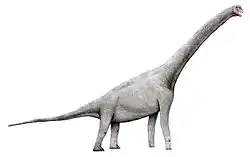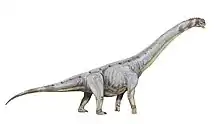Tambatitanis
Tambatitanis (meaning "Tamba giant", after Tamba, the name given to the northwest of Kansai, Japan[1] is an extinct genus of titanosauriform dinosaur from the Early Cretaceous (probably early Albian[2]) of Japan. It is known from a single type species, Tambatitanis amicitiae, which is known from the Sasayama Group.[1] It was probably around 14 meters long and its mass was estimated at some 4 tonnes.[2] It was a basal titanosauriform and possibly belonged to the Euhelopodidae.[1] The holotype was collected between 2006-2010.[3]
| Tambatitanis | |
|---|---|
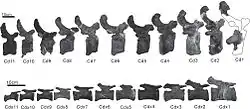 | |
| Caudal vertebrae | |
| Scientific classification | |
| Kingdom: | Animalia |
| Phylum: | Chordata |
| Clade: | Dinosauria |
| Clade: | Saurischia |
| Suborder: | †Sauropodomorpha |
| Clade: | †Sauropoda |
| Clade: | †Eusauropoda |
| Clade: | †Neosauropoda |
| Clade: | †Macronaria |
| Clade: | †Somphospondyli |
| Genus: | †Tambatitanis Saegusa & Ikeda, 2014 |
| Type species | |
| †Tambatitanis amicitiae Saegusa & Ikeda, 2014 | |
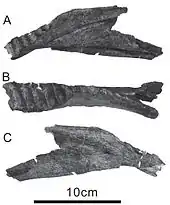
Dentary
References
- Saegusa, H.; Ikeda, T. (2014). "A new titanosauriform sauropod (Dinosauria: Saurischia) from the Lower Cretaceous of Hyogo, Japan". Zootaxa. 3848 (1): 1–66. doi:10.11646/zootaxa.3848.1.1. PMID 25112425.
- Paul, Gregory S. (2016). The Princeton Field Guide to Dinosaurs: Second Edition. Princeton, New Jersey: Princeton University Press. p. 224. ISBN 978-0-691-16766-4.
- H. Saegusa, S. Tanaka, T. Ikeda, T. Matsubara, H. Frutani and K. Handa. 2008. On the occurrence of sauropod and some associated vertebrate fossils from the Lower Cretaceous Sasayama Group of Hyogo Prefecture, SW Japan. Journal of Fossil Research 41(1):2-12
This article is issued from Wikipedia. The text is licensed under Creative Commons - Attribution - Sharealike. Additional terms may apply for the media files.





